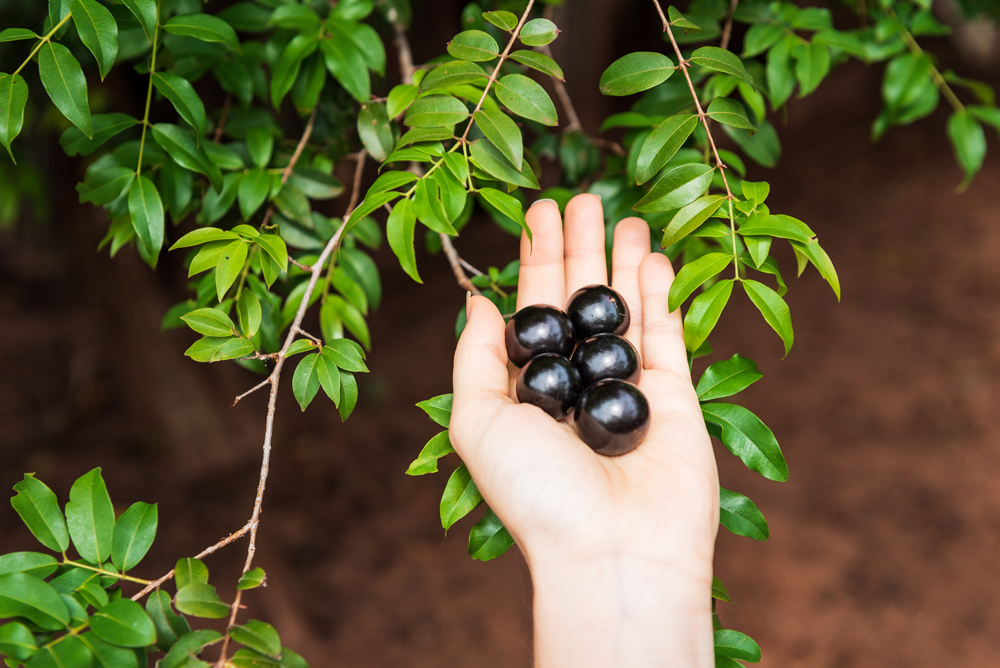Myrciaria cauliflora
Common Name:
Jaboticaba

General Information:
Jaboticaba, pronounced in five syllables just as it is spelled, is a member of the Myrtaceae (Myrtle) family and is known botanically as Eugenia cauliflora. (“Cauliflora” means that it flowers and bears fruit on the trunk, mature branches and exposed roots.) It is a relative of the guava and true myrtle. Its native range is from southern Brazil to southern California, southern Florida and Hawaii,(Tropical) Takes long time to begin flowering after potting as a bonsai.
The bark of the Jaboticaba is very smooth, creamy tan with a pinkish tint and patches of soft gray. Its habit of peeling off in curls as the trunk and branches expand is similar to the guava and crape myrtle. It is evergreen but sheds half its leaves each spring before new growth begins. The new leaves are pinkish but change to light to medium green. They are closely packed and are narrow and tapering. It blooms several times a year during warm months. The flower has delicate white petals with stamens and comes in clusters on the trunk, large branches and exposed roots. The tree begins to bear fruit when it is ten to fifteen years old. Its edible purple berries are globular shaped, 3/4” to 1 1/2” in diameter, have a tough skin and a juicy pulp. The fruit grows directly from the hard wood of the tree and develops very quickly; from open flower to ripe fruit in about three weeks. It is good to eat fresh, in preserves or in ice cream.
Available in nurseries in the warmer climates and from bonsai specialty growers.
Lighting:
It thrives in partial shade but will tolerate full sun if kept well watered.
Temperature:
Because it is native to a warm climate, it must be protected from freezing temperatures.
Watering:
Water adequately and frequently. It will not tolerate salt. Feeding: Acid fertilizer is best but Jaboticaba likes lots of food and will be thankful for just about anything you give it.
Pruning and wiring:
Early care must be given to avoid heavy branches on the upper portion of the tree as it sets heavy wood very quickly, especially toward its top. If nursery stock is obtained with heavy upper branches, remove them and train the new growth which will appear. Wounds tend to heal quickly. Any wiring should be done loosely and early in the growing season.
Propagation:
It is best propagated by air layering and by seed, but root cuttings will grow well too.
Repotting:
Repot only in warm weather. If the plant is healthy it is safe to remove up to two thirds of its roots. Jaboticaba prefers fertile, well drained but moisture retentive soil; azalea soil works well. The traditional brown bonsai container contrasts well with the light mottled bark and seems to highlight the new pink leaves. A soft blue green glaze is nice too with the bark and leaves.
Pests and diseases:
About the only pests bothering it are aphids on the new tender pink leaves and an occasional red spider mite attack.
Bibliography:
“Bonsai Hints & Tips”, Florida Bonsai, VIII, 3:39.
“Educational Forum, Eugenia cauliflora (Jaboticaba)”, by Trudy Santille, Florida Bonsai, VIII, 3:18-20.
“Jaboticaba”, by Mayna Hutchinson, Florida Bonsai, XIV, 2:2-9. “Jaboticaba - Graceful Lady of the Tropics”, by Martha Olga Botero de Gomez, Bonsai Magazine, XXXII, 3:11-13.
Also: Florida Landscape Plants,Watkins, pg. 299.
Compiled by Thomas L. Zane
